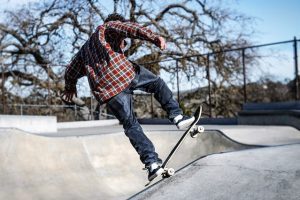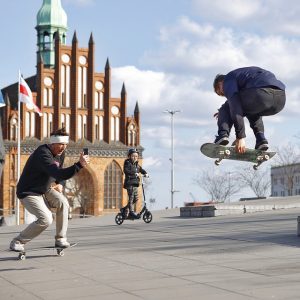We’re all on the hunt for creative ways to boost the act of physical coordination, and skateboarding might just be the answer we’ve been seeking.

As surprising as it might sound, this street sport isn’t only for thrilling tricks and high-speed rides; board riding is a powerful tool for mastering movement and grace. It’s also a great form of exercise. Let’s explore some of the benefits of skateboarding and learn how skateboarding can help improve your balance, cardio, fluidity of motion, and the act of coordinating physically. It also helps build communities.
Whether you’re an experienced skateboarding enthusiast or someone who’s never set foot on a board before, there’s something in here for everyone. So, let’s roll!
Skateboarding is part of the action sport, which includes extreme sports like snowboarding, surfing, and BMX.
- In this blog, we’ll learn attributes, such as how skateboarding requires skill, balance, and coordination, and the values, such as the adrenaline rush it provides. We’ll find out how it improves balance, grace, agility, and social skills. By the end of this article, you’ll be ready to ride your board at home or in the park.
Key Takeaways
- It’s no secret that skateboarding is an amazing activity for mastering movement and grace. Not only is it a fun way to spend time, but the balance and new tricks involved help to refine the coordination of physical and graceful movement. From learning the basics to mastering advanced tricks, skateboarding is a great way to have fun and work on physical skills.
- Skateboarding has a long list of benefits. Benefits of skateboarding include improvement of balance, agility, and grace. Moreover, it also improves coordination. Skateboarding is a great way to stay active and healthy and can even be used to bond with friends and family.
- While reaping the benefits of skateboarding, safety should always be a top priority. So, grab your board, helmet, and wrist guards before you start ollie-ing.
Understanding The Basics Of The Sport
Before you can unleash your inner Tony Hawk and start skating for coordination, start with the essentials. Some of the benefits of skateboarding are:
- Skateboard riding has morphed into a cultural phenomenon, enhancing lives with its dynamic fusion of artistry and athleticism.
- It’s not just about cool tricks; it’s a full-body workout that hones your balance, agility, and strength.
- Besides being an exhilarating pastime, skateboards double as a practical means of transport, offering a fresh way to navigate and connect with your surroundings.
- Skateboarding fosters camaraderie and friendships and cultivates a sense of community.
Skateboarding Health Benefits

It Is All For Improving Balance, Grace And Agility
Perfecting The Art Of Graceful Movements
Skateboarding is an art form that allows riders to express themselves through fluid, graceful movements.
- These graceful movements aren’t just for show, they serve others by inspiring them with the beauty of athleticism. Balancing on a skateboard not only improves agility but also allows the skateboarder to execute smooth and beautiful actions, reflecting a dance-like quality.

Advanced Skateboarding Techniques
Safety Tips
Frequently Asked Questions (FAQs)
Do Skate Riders Have High Pain Tolerance?
- Skateboarders have a relatively high pain threshold, a form of injury prevention, which makes it simpler for them to ignore their pains and deny that they even exist when training. When their legs hurt, they find ways to make up for it by riding slightly differently or even shaking their legs slightly.
Should You Work Out Before Or After Riding A Board?
- A little workout can help you be more flexible, minimize muscular stiffness, and skate for longer. Before skateboarding, you should warm up by performing dynamic stretches and quick muscle-warming activities. Warming up any muscles is advised. This can keep you from being hurt, prevent the most common injuries, and extend your career. Don’t risk your muscles if they’re not ready yet.
Is Riding A Skateboard Good For Your Knees?
- It isn’t specifically bad for the knees. On the contrary, in fact. Its intense knee stimulation improves joint mobility and fortifies the core muscles that surround ligaments to prevent knee injuries. However, attempting certain heights while skating—whether doing airs on ramps or leaping down gaps—can be quite taxing on the knees and lead to arthritis at an earlier age.
Does Skateboarding Help With Other Sports?
- Yes, it can improve your physical fitness in other sports as well. It can help you get more control if you’ve always felt a little clumsier than a normal person. The learning curve can be challenging, but in the long run, you’ll benefit from having better coordination for multitasking, driving, and other sports like baseball, basketball, soccer, and football, self-confidence, patience, and regular daily tasks. You can develop a keen sense of spatial awareness that contributes to being successful in other sports.
Is Skateboarding An Endurance Sport?
- It is a fantastic aerobic and anaerobic workout that has several health benefits. Other health benefits of skateboarding are enhancement of physical stamina, balance and coordination, and agility. Additionally, it aids in raising heart rate, which improves cardiovascular health. Riders occasionally execute tricks, which puts additional strain on their physical stamina and flexibility.
Why Is Skateboarding The Hardest Sport?
- Dexterity and perseverance are necessary for skaters’ success. Additionally, it may be very merciless since failure frequently results in hitting concrete. It has a fairly steep learning curve, so for novice skaters, progressing to even the most basic feats frequently takes months. Learning new tricks can be easy for some, while others might take a longer time to adjust.
How Does Skateboarding Affect The Brain?
What Muscles Do Skaters Target?
How Do Riders Fall And Not Get Hurt?
- Along with having a high pain threshold, some skaters also employ pain-relieving techniques to reduce discomfort during falls. Head and elbows should be tucked in. Landing on your head will hurt far more than landing on your butt, back, or stomach. The places that you don’t want to land on can be protected with mouthpieces, helmets, and knee and elbow pads. As they fall, some skateboarders also attempt to tuck and roll. To master the art of falling in skateboarding, beginner riders must practice them.
Why Is Skateboarding So Tiring?
- To put it another way, you are, for lack of a better phrase, “wearing them down” every time you skate since you are employing specific bodily systems to fuel your workouts. When you skate, your energy reserves will be depleted, your muscles will suffer, or you could get psychologically exhausted from repeatedly slamming a technique.
